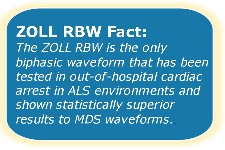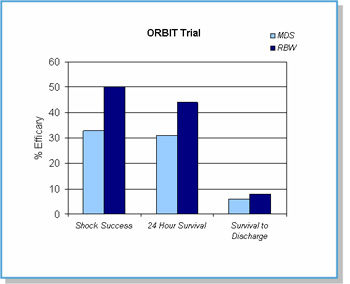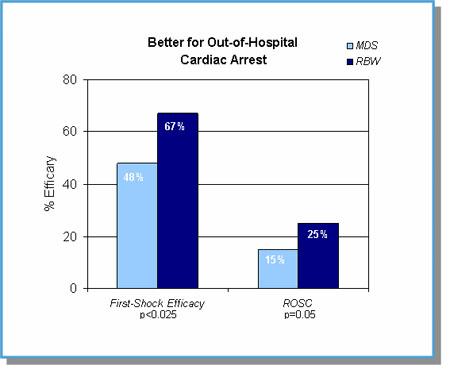Superior for Defibrillation of Out-of-Hospital Cardiac Arrest
Results from two clinical trials using the ZOLL Rectilinear Biphasic™ waveform (RBW) in out-of-hospital cardiac arrest ALS response systems have recently been presented. Both studies confirm the superiority of the ZOLL RBW over monophasic damped sine (MDS) waveforms in out-of-hospital cardiac arrest.*
Stothert et al. also recently published the results from a retrospective clinical trial of 294 patients treated for cardiac arrest. Results showed a 40% increase in first shock efficacy and a 67% increase in return of spontaneous circulation with normal sinus rhythm.
The Trend Continues in Out-of-Hospital Cardiac Arrest
Stothert et al. Prehospital Emergency Care. 2002; 6:149-150 (abstract).
Results from the Out-of-hospital Rectilinear Biphasic Intervention Trial (ORBIT) showed the ZOLL RBW to have superior efficacy to MDS waveforms in out-of-hospital cardiac arrest treated with advanced life support (ALS). Unlike other out-of-hospital biphasic defibrillation trials, the ORBIT trial used a much more challenging protocol with ALS responders instead of first responders, and a definition of success as organized electrical rhythms rather than absence of VF. This makes the 55% increase in efficacy even more significant in the face of long down times. Further, the ORBIT trial is the only out-of-hospital biphasic study to show statistically significant improvement in 24-hour survival (Figure 1).


Read on to uncover the unique advantages of ZOLL's Rectilinear Biphasic waveform:
Principles of Electricity
More Current at 200J than other biphasic waveforms at 360JOptimal Duration for Defibrillation Shocks
Superior for Cardioversion of Atrial Fibrillation
Superior for Defibrillation of Ventricular Fibrillation
Superior for Defibrillation of Out-of-Hospital Cardiac Arrest
Pediatric Biphasic Recommendations
Bibliography
*The data demonstrates the equivalent efficacy of low energy rectilinear biphasic shocks compared to standard high energy monophasic shocks for transthoracic defibrillation for all patients in VT/VF at the 95% confidence level. The data also demonstrate the superior efficacy of low energy rectilinear biphasic shocks compared to standard high energy monophasic shocks in patients in VT/VF with high transthoracic impedance at the 90% confidence level.
